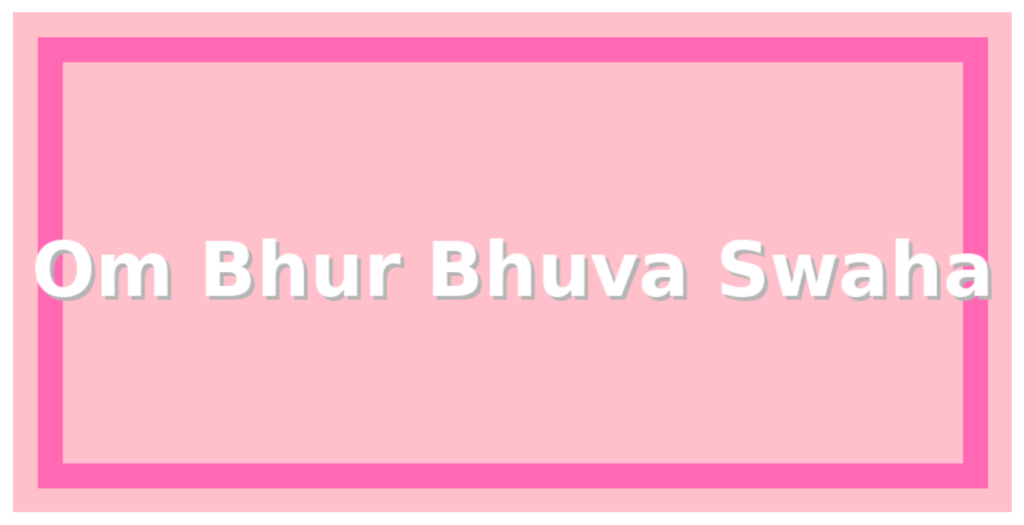Chanting ancient mantras is not merely a tradition but a gateway to spiritual awakening. One such revered chant is Om bhur bhuva swaha. This sacred verse, often whispered or sung during meditation and rituals, holds immense spiritual and healing significance in Vedic traditions.
Derived from the Gayatri Mantra, it is more than just a string of words. It’s a vibration that aligns your energy with the universe. The phrase encapsulates the earth (bhur), the atmosphere (bhuva), and the heavens (swaha), thereby invoking harmony across all planes of existence. And right from the start, it’s worth noting — this mantra isn’t exclusive to monks or sages. Anyone can benefit from it.
Whether you’re seeking calmness, clarity, or divine connection, the journey into this mantra’s wisdom can be life-altering.
The Origin of Om Bhur Bhuva Swaha
This powerful chant forms the opening line of the Gayatri Mantra, one of the most ancient and sacred hymns from the Rigveda, dating back over 3,000 years. The seer Vishwamitra is credited with revealing the mantra to humanity. It’s not merely a religious verse but a universal prayer for enlightenment and divine guidance.
Breakdown of the Mantra’s Components
Let’s delve deeper into the essence of each word:
-
Om: the primal sound; the vibration of the universe.
-
Bhur: The physical realm (Earth).
-
Bhuva: The mental realm (atmosphere or mind).
-
Swaha: the celestial or spiritual realm (heaven).
This trinity bridges the body, mind, and spirit. It’s a holistic approach to living consciously, embracing earthly existence while aiming for spiritual elevation.
Why Is This Mantra Repeated in Rituals?
During fire ceremonies (havan), the phrase om bhur bhuva swaha is recited while offering items into the sacred fire. But why?
It’s believed that this invocation purifies the offering and the surroundings, acting as a divine passport to deliver prayers across realms. The word “swaha” itself is an offering — symbolizing surrender and transformation.
Spiritual Meaning Behind Om Bhur Bhuva Swaha
More than just a chant, this mantra encapsulates a request for inner transformation. It’s a meditative bridge from chaos to calm, ego to humility, and ignorance to wisdom.
Regular chanting can dissolve inner turbulence, bringing a sense of cosmic rhythm and internal balance. And let’s face it — in today’s rushed, noisy world, that’s a true gift.
Health and Psychological Benefits of the Mantra
Several practitioners and holistic healers have observed powerful mental and emotional shifts through mantra repetition. Here’s how om bhur bhuva swaha may benefit you:
-
Reduces anxiety and mental chatter.
-
Enhances focus and emotional resilience.
-
Improves sleep quality and calms the nervous system.
-
Rejuvenates the energy body (also known as Pranamaya Kosha).
Scientific View: Sound Vibration and Its Effects
Modern science is catching up with ancient wisdom. Studies show that chanting certain syllables creates resonances that affect the brain positively. MRI scans of regular chanters show increased activity in the prefrontal cortex — the region associated with focus, decision-making, and empathy.
The chant’s vibration gently massages internal organs, especially the vagus nerve, triggering a relaxation response. Fascinating, isn’t it?
Om Bhur Bhuva Swaha in Daily Life
This mantra isn’t reserved just for temples or yoga mats. Incorporate it into your morning or bedtime routine:
-
Morning: Chant it three or nine times post-shower to energize your aura.
-
Commute: Whisper internally while traveling for mental clarity.
-
Stressful moments: Use it as a reset tool — a spiritual deep breath.
Is It a Religious Mantra?
Although rooted in Vedic Hinduism, its application transcends religious boundaries. Just like yoga, om bhur bhuva swaha is a universal mantra. Think of it as a spiritual compass rather than a religious decree.
The Connection to the Sun (Savitur)
The full Gayatri Mantra, of which this line is the beginning, worships the sun — not merely as a celestial body but as a symbol of divine consciousness and source of life.
By starting with om bhur bhuva swaha, the seeker aligns with this luminous source, asking for enlightenment and clarity in thought and action.
Effects on Chakras and Energy Centers
Each syllable resonates with different energy points in the body:
-
Om – Crown chakra
-
Bhur – Root chakra
-
Bhuva – Heart chakra
-
Swaha – Throat chakra
This alignment fosters energetic balance, opening pathways for healing and higher consciousness.
Chanting Tips for Beginners
-
Start slow: Chant it aloud or internally 9 times a day.
-
Focus on breath: Let each word guide your inhale and exhale.
-
Use a mala: A 108-bead mala helps maintain count and enhances focus.
Morning Ritual With the Mantra
Rise with the sun, sit in a quiet space, and chant om bhur bhuva swaha while facing the east. You’ll be surprised at how this simple habit transforms your mornings into sanctuaries of peace.
Evening Relaxation Practice
After a long day, light a candle, close your eyes, and repeat the chant. Let each syllable melt the day’s stress. This can become your emotional detox therapy.
The Role of Intention While Chanting
Chanting without intention is like shooting arrows in the dark. Before you begin, set a clear intention — peace, clarity, strength, or healing. The universe listens.
Guided Meditation Incorporating the Mantra
Visualize yourself surrounded by light as you chant. With each repetition, imagine the light growing brighter, cleansing every cell. This visualization deepens the mantra’s effects.
Modern-Day Relevance
In an age of overstimulation, om bhur bhuva swaha is the ancient antidote. It’s mindfulness in melody, a healing balm for the tech-tired soul.
Global Adoption of the Mantra
From yoga studios in New York to retreats in Bali, this mantra has traveled globally. Western practitioners embrace it not just for its spiritual depth but for its calming and centering effect.
Difference Between Om and Om Bhur Bhuva Swaha
While Om is the seed sound, Om Bhur Bhuva Swaha is the full invocation. The former is universal, while the latter has directional intent — upward and inward transformation.
Sacred Geometry and the Mantra
Sound creates shape. Chanting this mantra generates symmetrical patterns in water and sand — proof of its harmonizing frequencies. It literally imprints order in chaos.
Power of Repetition: 108 Times Explained
Why 108? It’s a sacred number representing the universe’s wholeness. Chanting 108 times anchors the mantra deep into your subconscious.
Children and Chanting
Yes, children can benefit too. It boosts memory, reduces screen-induced stress, and cultivates empathy. Plus, it’s a fun family bonding activity!
Also read: Diet Mountain Dew Lyrics: A Deep Dive into Lana Del Rey’s Vintage Dreamscape
Common Myths and Misunderstandings
Some believe only priests should chant it. Not true. This mantra belongs to every seeker. Respect, not hierarchy, is what matters here.
Can It Be Played as Music?
Absolutely! Many use musical renditions during yoga, study, or relaxation. Just ensure it’s from a respectful source.
When Not to Chant
Avoid chanting right after eating or while multitasking. Presence is key to unlocking its power.
Conclusion
In a world flooded with distractions, om bhur bhuva swaha is a sacred lifeline to inner peace. It’s simple yet profound, ancient yet modern, spiritual yet scientific. Whether you’re a seeker, skeptic, or somewhere in between, this mantra invites you to pause, breathe, and reconnect with the divine rhythm of life.
FAQs
What does Om Bhur Bhuva Swaha mean?
It is a Vedic invocation calling upon Earth, atmosphere, and heaven for purification and spiritual awakening.
Can non-Hindus chant Om Bhur Bhuva Swaha?
Yes, it is a universal mantra open to all, irrespective of religion or background.
How many times should one chant the mantra?
Start with 9 times daily and gradually build to 108 for deeper results.
Is there a specific time to chant it?
Traditionally, during sunrise and sunset, but it can be practiced anytime you seek clarity or peace.
Does chanting really help with stress?
Yes, it calms the nervous system, reduces cortisol, and enhances mental well-being.
Can children chant this mantra?
Absolutely. It promotes calmness, focus, and positive energy in young minds.



